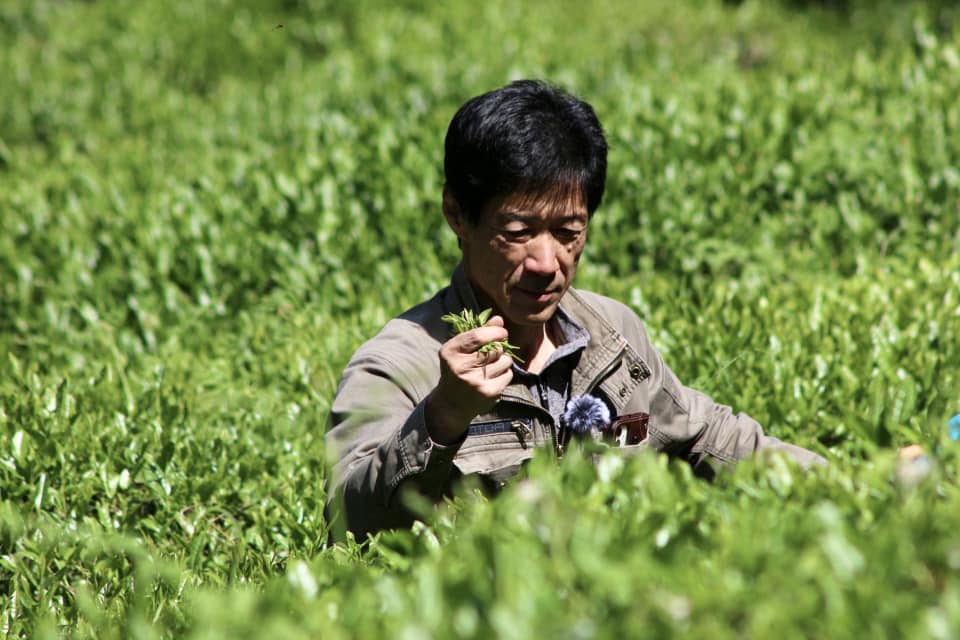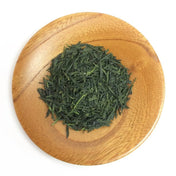The 2023 Shincha season is here! Many tea farms will be starting, or have already started their very first tea harvest for the new season. We say very first because Japanese green tea is harvested a few times a year (although this varies from farm to farm), usually in the spring, summer, and finally, in the fall. Spring is considered the best time to harvest and is highly anticipated because of its superior taste, and because of a long period of waiting! During the winter, the tea plant is in its dormant phase, resting and getting ready to flourish with the young green leaves and buds that are nutrient rich for the upcoming shincha harvest. While today, most of the tea harvesting is done with the help of machines, we felt it would be a good opportunity to touch on the different ways in which tea is, and has been harvested.
Hand-picking Tea
The most traditional way tea is harvested is by hand. Before machine harvesting became the norm, tea farmers picked tea buds, one by one. Today, hand-picking tea is done mainly to make very high quality teas such as gyokuro and top quality sencha. While I myself have never experienced hand-picking tea, it is said that if one gently pulls on the bud of the new tea leaf, there is a sweet spot where the young tea leaf will naturally detach. This is where the skill and experience of tea picking is critical and of course this makes delicious tea! The advantage of hand-picking tea is that one can focus on harvesting selecting only the first leaf, or two and bud (depending on the picking standard of the particular tea), whereas tea harvest machines do not have the ability to carefully select; hence, hand-picked tea can lead to the finest tea.
In Japan, we refer to people who hand harvest tea as “Ocha-tsumi-san” (literally, tea pickers). Although it may seem like an easy task, it takes years of experience to pluck the optimal buds both quickly and thoroughly from the tea plant. During my tea farmer interview with Ayumi Kinezuka (Cyittorattu) from Fujieda-city, Shizuoka Prefecture, she touched on this incredible skill of the grandma generation:
“One aspect of tea farming that I have been trying to continue transmitting is the process of hand-picking tea leaves. My grandma’s generation (she has passed away), they started hand-picking tea leaves from a very young age, as young as 4 or 5 years old! You can see this today in tea farmers who are in their 70’s or 80’s. They are very good but also very fast in hand-picking tea leaves, it will really surprise you. In hand-picking tea leaves, the important thing is not just to pick the early buds but also to pick it nicely and it’s also about the amount you can pick. It’s really laborious work! So this depends on practice and repetition.”
 Some of the experienced and skilful tea pickers. Photo by Ryuji Ogata.
Some of the experienced and skilful tea pickers. Photo by Ryuji Ogata.
In some of the major tea growing regions where top quality tea is made, one may see dozens of tea pickers attach "biku" (basket to collect the tea leaves) to their waists from early in the morning. An experienced grandma can pick 10-15kg of tea all by herself. Sadly, similar to many of the incredible traditional craftsmanship in Japan, hand-picking tea leaves is on the brink of disappearing. There are, however, tea farmers such as Ayumi-san who have been trying to share this art with the younger generations by inviting friends and people to experience hand-picking tea leaves for the very first flush. Tea farmer Kajihara-san also organizes an event every year to hand-pick tea leaves at his tea farm located in the beautiful mountains of Ashikita Village, Kumamoto Prefecture.
 Tea Farmer Toshihiro Kajihara and their hand-picking crew from this year! Photo by Ryuji Ogata.
Tea Farmer Toshihiro Kajihara and their hand-picking crew from this year! Photo by Ryuji Ogata.
Japanese Tea Harvest Scissors (Shears)
Tea harvest scissors can be thought of as the in-between phase that was present before tea harvest machines became the norm. These are very large scissors that are used to harvest and cut tea leaves, similar to the type professional gardeners use. There is a bag which attaches to the blade of the scissors where the leaves collect (If you are curious about seeing these scissors in action, here is a youtube video of tea harvest scissors being used). These unique scissors were invented in 1915 by Sanpei Uchida, a blacksmith in Nishikata Village (which is now Kikugawa Town), Shizuoka Prefecture. This was a time period when a large amount of tea was produced for overseas export. A neat fact is that tea harvest scissors were actually sung about in Japanese folk song in 1927. While the date is rather recent, this is probably one of the few examples where an agricultural tool was featured in Japanese folklore.
To provide a bit more history, tea harvest scissors were invented 17 years after Kenzo Takabayashi invented the machine for rolling tea (note that prior to this, tea was exclusively hand-rolled). The mechanization of the tea-making process matched increasing global demand. The invention of tea picking scissors was therefore born from this situation. Even towards the end of the Meiji Era (around 1910), it is said that farmers began experimenting harvesting with scissors but this method did not spread quickly. The scissors Uchida-san made however, were favorable as he designed the scissors in such a way as to have a splint on one blade and a mouthpiece on the other to hold a bag. He even grew tea near his workshop so he could easily test new models. Moreover, it is said that Uchida-san’s held pride in the blades’ sharpness. His meticulous work paid off. For example, it is believed that he checked each pair of scissors himself before shipment and that he did the process of quenching (i.e., involving the rapid cooling of metal in order to adjust the mechanical properties) at night when the color of the fire could clearly be seen.
In 1951, research on the automation of the tea harvest scissors began. Subsequently, a prototype of the first man-held automated tea harvester was introduced and patented in 1956. Tea harvest scissors are rarely used now, as there are more efficient tea harvest machines, which we will touch on below.
Two Person operated Tea Harvest Machine
If you have ever visited tea farms or witnessed tea harvesting, the hand held, 2-person tea harvest machine may be familiar to you. To harvest the tea leaves, the blades will slide and the harvested tea leaves will be collected, thanks to air being blown into a bag that is attached to the back of the machine. As one can imagine, this harvest machine can harvest tea leaves at a rate that is well over 10 times faster than hand-picking. Moreover, another benefit of this type of harvester is that it has the advantage of being used on steep and sloped tea fields and curved ridges. They can also be turned around in a small radius, which makes them quite versatile. One downside is that their smooth operation sometimes requires a 3-4 person crew, one person to keep the bag of tea from getting caught in the aisle and another to carry the bags to the collection point.
 Summer harvesting in Wazuka, Kyoto Prefecture. The observer is actually a volunteer who is helping pull out the weeds. The summer time is especially a time for weeding!
Summer harvesting in Wazuka, Kyoto Prefecture. The observer is actually a volunteer who is helping pull out the weeds. The summer time is especially a time for weeding!

Autumn harvesting; Wazuka, Kyoto Prefecture.
While tea harvest machines have drastically facilitated hand picking, machine harvesting must also be done with care and coordination between the operators is key. For instance, if the machine is passed too deep into the tea bushes, the harvest will include older tea leaves, thick stems, and can damage the tea plant. Family operated tea farms that use 2-person harvest machines even talk about the importance of not getting into fights during tea harvest time! During the busy harvest period(s), many tea farms will obtain help in harvesting from part-time workers and these part timers may not have the experience to smoothly pass the harvester over the bushes.
Rider-type Tea Harvest Machine

Lastly, there are the person-driven large harvest machines. These are similar to combine harvesters utilized to harvest rice and is currently the most efficient type of harvest machine for tea. On these machines, the height of the blades can be dynamically adjusted by sensors and computer systems. While extremely efficient in the sense that only 1 person can harvest a large area, it is perhaps important to keep in mind that these specific harvest machines are only well-suited to use on flatter tea fields and require more turn around space (e.g., not the steep tea farms located in Wazuka, Kyoto Prefecture). These types of machines are typically used in larger scale tea fields such as in Kagoshima Prefecture around the Makinohara region. Tea farmer Mataki Tatefumi (from Sueyoshi Tea Atelier) and Koukien Tea Garden whom I was able to visit with in March use these types of machines to produce high quality tea since they are both located in relatively flat areas in Kagoshima Prefecture.
Thinking about Tea Field Scenery
Now that we have provided a general overview of the different types of harvesting methods, it may be interesting to note how the scenery of tea fields (i.e., the look of the tea fields) is determined by the harvest method. To elaborate a bit, the tea fields one sees today in Japan actually have a recent origin, beginning in the 1960’s, around the time when the Tokyo Olympic games were hosted. Our traditional tea fields, which date back to the Edo-period (1603 – 1868) were not planted in such an linear fashion. Rather, traditional Japanese tea fields were characterized by a sort of “bumpy” look due to the arrangement of individual bushes, perhaps not as aesthetically pleasing as the symmetrical tea fields of today. However, this form maximized production from each individually hand harvested bush that works would pluck from all sides.
Today, due to modern machine harvesting techniques and lack of labor, tea is harvested only from the upper surface of the tea bush. Which means, the upward growth of the tea bush is controlled by regular trimming while the sides of the tea bushes continue to grow, forming rows of tea bushes that seem to be connected side-by-side. Voilà! This type of harvesting and care of tea bushes leads to the beautiful symmetrical tea fields one generally sees in the major tea producing regions of Japan.

Related reads: An article on tea history which mentions tea harvest scissors; Tea History Shines into the Future.
Featured image: Tea farmer Toshihiro Kajihara from Kajihara Tea Garden hand-picking tea in Ashikita, Kumamoto Prefecture. Photo by Ryuji Ogata.
Have additional questions about Japanese tea harvesting? Please don't hesitate to post comments and/or questions below. Or directly contact me (Moé Kishida): moe@yunomi.life.


